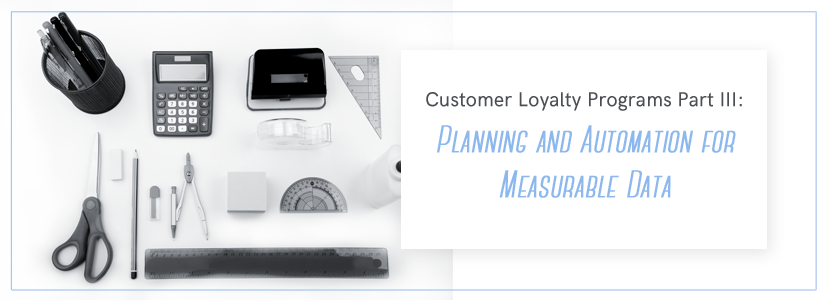
Customer Loyalty Programs Part III: Planning & Automation for Measurable Data
Thanks for finishing off our Customer Loyalty Program discussion with us in this Part III. In Part I we outlined the types of programs your company can run and in Part II we went over tips for planning the right program. There’s one more step to pulling together the right program—making sure you are set up to get and use the right data.
What to Track
The success of your program depends on your goals. For example, are you looking for more immediate sales or is the frequency of repeat sales the most important measure? Before starting your program, think about the priorities you’ve set and which metrics are the best indicators of meeting those goals, such as:
⋅ Engagement and enrollment—If visibility is a key goal, the level of enrollment can offer an indication of how often you’re reaching your customers. You also want to keep track of how often customers engage with various touchpoint offers and reminders to gauge whether your message continues to draw interest.
⋅ New Sales—For example, if you run an enrollment bonus campaign, track whether there is any increase in new customers based on the bonus.
⋅ Customer Lifetime Value—Keep track of whether loyalty customers buy in greater quantities or more frequently.
⋅ Customer Churn Rate—Does your loyalty program make customers loyal for longer? Track the length of your customer relationships and judge whether loyalty members cut ties less frequently.
Planning for Measurable Data with the Right Program and Automation
Your program structure and the tools you use are import to tracking the right data. Keep the following in mind when planning your program:
⋅ Integrating with Customer Relationship Management (CRM) and Point-of-Sale (POS) systems—Make sure that you are adding a customer’s use and engagement with a loyalty program to your general customer records so that you can better target the customer and better understand the customer journey. You’ll also need to keep track of customer loyalty offers at the time of purchase, so make a plan for how the program integrates with your POS.
⋅ Integrating existing email lists and tracking engagement and conversions—When you start your program, you’ll want to be able to reach out to the customers you already have, so plan targeted advertising and use your existing lists. Tracking the conversion rate of existing customers helps determine the value of your program to customers who already appreciate your products and services.
⋅ Tracking engagement and conversions via online advertising, website, mobile apps and social media—Make sure you can track response rates to social media campaigns and other online advertising so that you know if you are reaching new customers through each platform.
⋅ Look for inbound leads or use campaign-specific codes—Track your general advertising engagement by tracking who clicks, browses and converts. You can also segment your tracking by using campaign-specific offer codes, to more easily single out engagement and conversion for program trials or segmented customer lists.
⋅ Automating remarketing based on engagement—Use the data you gather on engagement to automatically create remarketing lists, and plan for automated remarketing ads and additional offers to entice interested customers. Don’t forget to track across channels, including website traffic, email engagement and social media campaigns.
Planning is huge when you’re talking about a program that you want to be tied to your products and services in the long term. Get in touch and we can help you put in place the right systems and support for your loyalty program.

